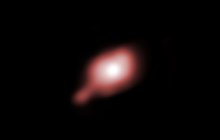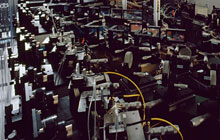AMBER
Astronomical Multi-BEam combineR
AMBER, along with MIDI, is an instrument that was installed on the Very Large Telescope Interferometer (VLTI) at the Paranal Observatory and has now been decommissioned. Interferometry is the technique of combining beams of light collected by several telescopes from an astronomical object to observe and analyse the object with a high degree of detail. By using several telescopes, we get the same detail as if we used one giant mirror — something that is not always possible to construct. AMBER, however, did not directly make images of the objects it observed: instead each pair of telescopes produces interference fringes whose brightness and contrast give some information about the shape of the object.
"The main purpose of AMBER is to study the close environments of astronomical objects, helping us to constrain the physical sizes and geometry of the sources," said Sridhar Rengaswamy, one of the Instrument Scientists for AMBER, before the instrument was decommissioned. "AMBER’s ability to detect very fine detail has helped us to discover large bubbles of gas moving in the atmosphere of the red supergiant star Betelgeuse, as well as showing us a disc surrounding a very young, massive star for the first time. AMBER observations have also led to the discovery that the yellow hypergiant star HR5171 A is the largest of its kind, being two to three times bigger than expected."
 Whereas MIDI uses either two Unit Telescopes (UTs) or two Auxiliary Telescopes (ATs), AMBER could combine the light from a configuration of three telescopes simultaneously. This increases the efficiency of observations as more baselines — the lines between two of the telescopes (reaching 130 metres in length for the UTs and 200 metres for the ATs) — can be used at once. The more baselines we use, the more information we acquire about an object, because each baseline corresponds to observing a particular part of the object. You can think about this in musical terms: the object represents the complete song, and each baseline represents the individual notes that make up the piece. The more baselines we have, the more notes we get, and the more complete our copy of the song is.
Whereas MIDI uses either two Unit Telescopes (UTs) or two Auxiliary Telescopes (ATs), AMBER could combine the light from a configuration of three telescopes simultaneously. This increases the efficiency of observations as more baselines — the lines between two of the telescopes (reaching 130 metres in length for the UTs and 200 metres for the ATs) — can be used at once. The more baselines we use, the more information we acquire about an object, because each baseline corresponds to observing a particular part of the object. You can think about this in musical terms: the object represents the complete song, and each baseline represents the individual notes that make up the piece. The more baselines we have, the more notes we get, and the more complete our copy of the song is.
“Because of the Earth’s rotation, the apparent distance and angle of the baselines as seen from the astronomical source we observe are constantly changing over the course of the night,” explains Rebekka Grellman, Instrument Fellow for AMBER. “This means that we don't just get three points with three baselines, but many more (depending on the position on the object on the sky and the time we have for the observation). This, in the end, is important if you really want to reconstruct images, which of course is only possible with a huge number of observations.”
AMBER operated in the near-infrared part of the spectrum between 1.0 and 2.4 micrometres, with the aid of a fringe tracker by the name of FINITO (Fringe-tracking Instrument of NIce and TOrino) which results in clearer fringes. Whereas the MACAO adaptive optics system compensates for atmospheric turbulence, FINITO ensures that the incoming light beams from each telescope reach the detector at the same time by sending a signal to the delay lines of the VLTI to move by a given amount.
The spectroscopic capabilities of AMBER allowed astronomers to differentiate between individual spectral lines (the signatures that tell us which elements astronomical objects are made up of) and then distinguish the region from where they are emitted. This is known as spectro-interferometry. “For example, if you observe one particular line that has been emitted from atomic hydrogen atoms around young stars, you can see whether it is originating from the surrounding dusty disc, an outflow, or from the stellar surface itself and thus create different wind models,” explains Rebekka. “Or you could look at the spectral lines being emitted in the innermost regions of the disc to see which molecules are produced there.”
Science highlights with AMBER
- Best ever image of a star’s surface and atmosphere (eso 1726)
- Highest resolution image of Eta Carinae (eso1637)
- AMBER discovers yellow hypergiant star, one of the ten largest stars ever detected (eso1409)
- Dusty surprise around a giant black hole (eso1327)
- Sharp view of Betelgeuse shows how supermassive stars lose mass (eso0927)
- Massive stars shown to form in the same way as smaller stars (eso1029)
|
The columns marked UT1, UT2, and UT4 show data from three of the individual 8.2-metre Unit Telescopes, which were then combined interferometrically. The resultant fringes are shown in the column marked VLTI. The bright feature is the Paschen-α emission line from atomic hydrogen gas, redshifted to a wavelength of 2.17 µm due to the quasar’s distance of about two billion light-years. This image is a rare example of a five-second exposure that reveals the fringes. In real use, many much shorter 0.3-second observations must be made.The new blind observation mode allows these shorter exposures to be successfully combined. |
AMBERThe authoritative technical specifications as offered for astronomical observations are available from the Science Operation page.
|


